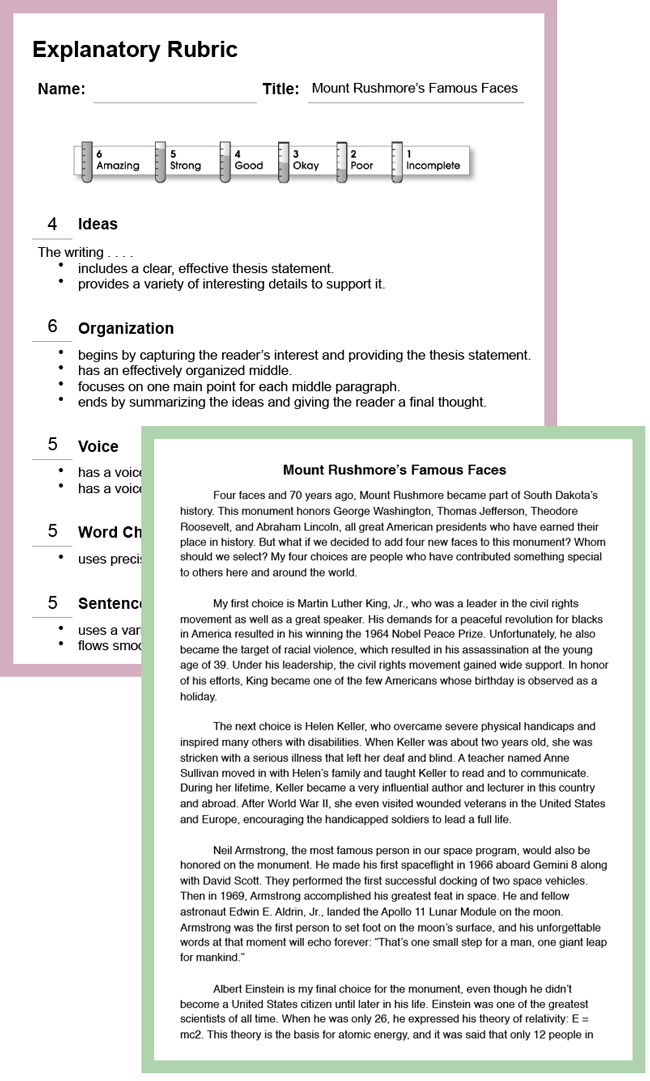“Good assessment starts with a vision of success.”
—Rick Stiggins
Effective writing assessment begins with clear expectations. Share with your students the traits of effective writing—ideas, organization, voice, word choice, sentence fluency, and conventions. Using the traits is easy. Just assess writing with one of these trait-based assessment tools: a teacher rating sheet, a general writing rubric, or a mode-specific rubric for narrative, explanatory, persuasive, response, research, or workplace writing.
Also check out these other assessment supports:
- Writing Assessment for Students
- The Traits of Effective Writing
- Using Writing Rubrics
- Using Writing Portfolios
- Answering Prompts on Writing Tests
Formative Writing Assessment
Writing assessment should not occur only at the end of a project. Instead, you should provide students ongoing feedback throughout the writing process. Give informal comments and focus on the "big three" traits: ideas, organization, and voice. These traits capture the key parts of communication: what a writer is saying (ideas), how the writer is saying it (organization), and to whom the writer is speaking (voice). Word choice and sentence fluency support these three traits. Correctness is important in the editing phase, but if you comment on spelling and mechanics before content, student will focus on surface corrections rather than the deeper issues that facilitate true communication.
You can provide this formative assessment during different types of writing conferences:
- Desk-Side Conferences occur when you stop at a student’s desk to ask questions and make responses. Questions should be open-ended so that the writer can clarify his or her own thinking about the writing.
- Scheduled Conferences give you 3 to 5 minutes to meet with a student in a more structured setting. The student may have a specific problem to discuss or may want you to assess his or her progress on a particular piece of writing. Try to praise one thing, ask an appropriate question, and offer one or two suggestions.
- Small-Group Conferences let you meet with 3 to 5 students who are at the same stage of the writing process. These conferences help students improve their writing and become better assessors.
Summative Writing Assessment
Don't feel the need to grade everything that students write. Trying to do so would not only be overwhelming but also counterproductive. The work students do during prewriting, writing, revising, and editing should not be graded as such because doing so would short-circuit the students' ability to write freely and communicate ideas. Also, writing-to-learn activities such as note taking and journaling should not be rigorously graded. You can give a score based on whether students produce a quantity of such material, but you should not do a full-trait evaluation on it. Students need to be able to write to learn new concepts and to gain fluency rather than worrying about every sentence, word, and comma.
Decide which assignments require summative assessment, and then grade the writing following this process:
- Ask students to submit prewriting and rough drafts with their final drafts.
- Scan final drafts once, focusing on the writing as a whole.
- Reread them, this time assessing them using the traits of effective writing.
- Make marginal notations, if necessary, as you read the drafts a second time.
- Scan the writing a third and final time. Note the feedback you have given.
- Complete your rating sheet or rubric, and, if necessary, write a summary comment.
Good writing assessment takes time. There is no magic button to push. Thankfully, you can reduce the burden on yourself by teaching your students to assess writing as well. This practice not only lightens your load but, more importantly, makes your students better writers.
